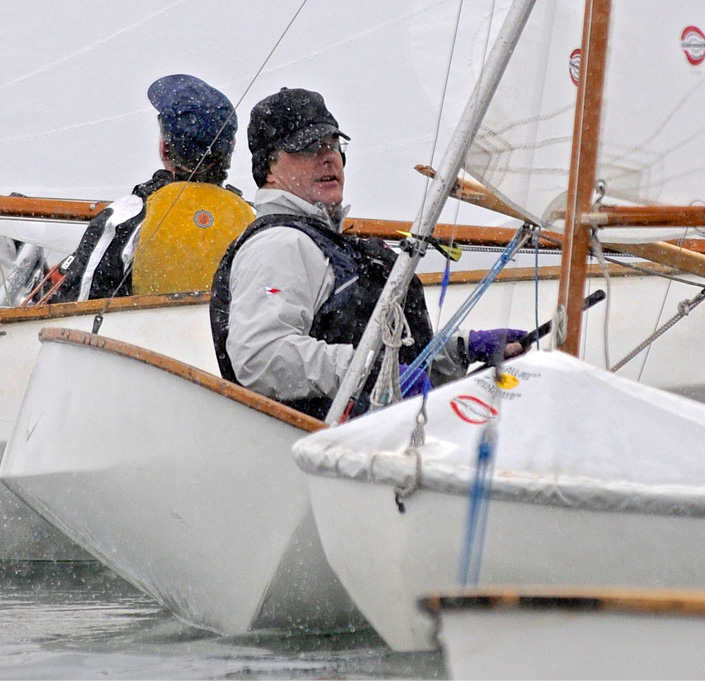By Allie Padin for the Larchmont Yacht Club Mainsheet

It’s time for racing on the colder side of the calendar. © Chuck Allen
Autumn is upon us and Frostbiters are getting ready to head out on the water for six months of racing on the colder side of the calendar. One could say that winning races in your highly competitive fleet is the mission, but truly, it’s staying warm that’s the real objective.
Weatherwise, some days are better than others. While most frostbiting days are cold, others are colder. Eyes tear up from the wind and noses run like faucets, not to mention popsicle fingers and toes. Cold weather racing isn’t for everyone, but for those brave enough to challenge Jack Frost to a tacking duel, staying warm is the key to success. Staying warm also increases the chances that a first-timer makes a return appearance to the course. To help in this mission, The Mainsheet spoke with some veteran skippers, crew and committee members and compiled the following list of tips and tricks to help you survive the frigid harbor.

Staying warm is the real objective, particularly in events like Indian Harbor Yacht Club’s Ice Cube Regatta. © Mary Alice Fisher/maryalicefisher.com
Layers, layers, layers
Moisture is bad news. Evaporation is a cooling process, and if you’re wet, the cooling is happening right on your skin. Nowhere in this article will you see an endorsement of anything cotton, which absorbs and traps moisture – a top contributing factor to making you cold, so pack cotton away with your seersucker and say goodbye to it until May.
Base layer
Wicking is the million-dollar word. Your first layer (yes, even your undergarments) should be made of material that wicks, meaning that it pulls moisture away from your skin. The best wicking fabrics are made from polyester and polypropylene, which comprise very fine woven strands of plastic that work to draw moisture away from skin. If you’re looking for a natural fiber, silk is also a great wicking fabric, but with a higher price tag.
Mid-layer
This is your insulating layer. Choose something somewhat snug (but not tight) that still allows you to get yourself up to windward comfortably – you don’t want to bulk up like the Staypuff Marshmallow Man to the point where you lose the ability to move your arms. An old wool sweater makes a great middle layer and is great at trapping a warm-air layer next to the skin. While wool can absorb some moisture, it stays warm even when it’s wet, and it’s another natural fiber. Fleece is a good option as well, with various thicknesses available.
Outer layer
Staying dry is the easiest way to stay warm. For the vast majority of frostbiters, this means the outer layer is going to be a drysuit…the word dry is right there in the name. If you take some spray over the bow, or wet snow from above, a drysuit is your best chance at staying dry. If you were to flip, and had chosen to go out in your regular foulies, it’s almost guaranteed that you’re heading in early, and chances are the chowder won’t be out yet, so weigh the risk accordingly.
There are a few variables when it comes to drysuits. The first: breathable vs. non-breathable. For skippers, and those who may be more prone to perspire, survey says that a breathable suit is the better option, especially in the fall and spring when temperatures can be higher than the dead of winter. As a crew, you’re less likely to work up a sweat and the difference between the two is less important. The second: the seal, neoprene vs. latex. Neoprene is less prone to ripping and perhaps more comfortable, but latex provides a better seal which is the entire point of wearing a drysuit.

If you’re crewing, don’t let your skipper advise you on warmth. If you’re driving, don’t give advice if you’ve never crewed. © Laurent Apollon Images
Thermogenesis
Thermo-what-nesis?! Thermogenesis is the process of heat production in organisms. Humans can experience dietary-induced thermogenesis, during which our bodies produce heat by metabolizing certain foods that take longer to digest. So…eating to stay warm!
Chose foods high in healthy fats, proteins, and carbohydrates. Nutrient-packed oats are a great source of whole grains and fiber, which, in addition to improving your cholesterol, keep you feeling full and warm. We’re all familiar with the urban legend about bananas on boats, but how about one while you’re still on shore? Bananas have a lot of vitamin B and magnesium, which help your glands function properly and regulate body temperature. Bananas can also boost your mood, so have a banana, because a cranky sailor is nobody’s friend.
Hydration
Water helps regulate your internal temperature. Dehydration causes your core temperature to drop, which may lead to hypothermia, and that’s a bad thing. Try a thermos full of hot ginger tea. Ginger, known to be good for digestive health, can stimulate thermogenesis. It’s also a diaphoretic, which means it will help your body warm from the inside out.
And if you need a boost to get rig-ready, caffeine-packed coffee boosts your metabolism and increase body temperature. Alcohol before racing is a bad idea for many reasons. Alcohol lowers your body’s core temperature, so although you may feel warm at first, it will be hard to stay warm over time. Alcohol also impairs your ability to shiver, which is the body’s way of boosting body temp. Race warm. That hot toddy will be waiting for ya!
A few pro tips from Brouck Anderson, a 20-year active fleet member, she has spent the past five at the tiller.
1. Crews, don’t take advice on warmth from your skipper (and skippers, stop giving advice if you’ve never crewed before). Ask a veteran crew instead. It’s a different position with different conditions and variables, and therefore calls for different apparel.
2. Invest in a warm wool hat with a chinstrap so it won’t snag on the boom during a tack.
3. Having spent hundreds of dollars on all the fancy glove technology, I still favor the college sailing trick of dishwasher gloves with wool liners underneath. Yes, yellow dishwasher gloves from the grocery store. Size down with the dish gloves as you want them to be a little tight, and buy them in bulk because they rip easily since they’re so thin – which is good for dexterity. Bring an extra pair of gloves and liners in a Ziploc bag on the boat to swap out when needed.
4. I like to wear wool socks with Gore-Tex socks over them. Ideally, your drysuit comes with Gore-Tex socks (the rubber drysuit feet freeze and are too cold, and the footless drysuits cut off your blood circulation which makes your feet colder). For footwear, I like big, fuzzy and waterproof Sorels. They weigh a lot which isn’t ideal, but a warm and happy crew equals a fast boat. Studies show that when you’re cold, cognitive performance and alertness are reduced. It’s hard to do your job when you’re freezing.
5. If all else fails and nothing keeps you warm as a crew, start driving. It’s easily ten degrees warmer as you move around more, use your hands, and stay dryer in the back of the boat. You’ll do better than you think (impostor syndrome is real), and if you decide you hate it, the experience will make you a better crew.
6. Lastly, to the skippers out there – don’t make your crew sponge out the boat between races when the water is cold. Bailing is one thing, but your hands are infinitely warmer than theirs from driving, so if the boat needs sponging that should be your job. Be kind.
Sunscreen
Yes, you still need sunscreen in winter. The ozone layer acts as Earth’s sunshield, absorbing harmful UV rays and it’s actually thinnest in winter. Freezing temperatures and vicious winds leave your skin dry and agitated, giving UV rays a better shot at your skin. So, lotion up!
Finally, a word from veteran Frostbite PRO Nick Langone: When it comes to staying warm, hand-warmers are a must-have. As a member of the RC, you can go through four to six every race day depending on your job. As PRO, my hands need to be free to hold a hand-held compass, and talk to the support boats on the VHF radio. Instead of gloves, I tie a sports muffler around my waist similar to what professional quarterbacks wear to keep their hands warm. Not only does the internal fabric keep my hands warm, but as an added bonus two or three hand-warmers inside does the trick. ■




